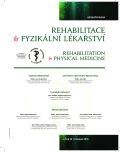Using Accelerometers to Assess the Effects of Hippotherapy on Movement Execution in Children with Spastic Cerebral Palsy - A Pilot Study
Authors:
H. Bednáříková; M. Janura; L. Bizovská
Authors‘ workplace:
Katedra přírodních věd v kinantropologii, Fakulta tělesné kultury, Univerzita Palackého v Olomouci
Published in:
Rehabil. fyz. Lék., 23, 2016, No. 4, pp. 190-194.
Category:
Original Papers
Overview
Hippotherapy is a form of physical therapy which uses motion of the horse’s back to achieve therapeutic effects. Most clients of hippotherapy are children with cerebral palsy (CP) or genetic disorders. Children with spastic CP often have affected postural stability of head, trunk and pelvis, balance and coordination, and abnormal gait. According to research studies by different authors, these symptoms can be lessened by hippotherapy. Although positive effects of hippotherapy are undeniable, most evidence on benefits of hippotherapy is still empirical, based on personal experiences of physical therapists. It appears there is a scarcity of scientific studies which can provide conclusive evidence for effectiveness of hippotherapy and use sophisticated systems for movement analysis. Our paper presents the use of accelerometry as a method of movement analysis suitable for field tests of effects of hippotherapy on the human body. The major advantages of this method are its simple application with little demands on the horse and client and the ease and speed of obtaining basic kinematic parameters needed for further movement analysis.
Keywords:
horse, cerebral palsy, rehabilitation, movement analysis
Sources
1. CULHANE, K. M., O’CONNOR, M., LYONS, D., LYONS, G. M.: Accelerometers in rehabilitation medicine for older adults. Age Ageing, roč. 34, 2005, č. 6, s. 556-560.
2. DVOŘÁKOVÁ, T., PAVELKOVÁ, J., JANURA, M., SVOBODA, Z.: Analýza pohybu v hipoterapii z pohledu biomechaniky. Rehabil. fyz. Lék., roč. 12, 2005, č. 4, s. 183-187.
3. ENCHEFF, J. L., ARMSTRONG, CH., MASTERSON, M., FOX, CH., GRIBBLE, P.: Hippotherapy effects on trunk, pelvic, and hip motion during ambulation in children with neurological impairments. Pediatr. Phys. Ther., roč. 24, 2012, č. 3, s. 242-250.
4. GAGE, J. R.: Gait analysis in celebral palsy. Oxford, Mac Keith Press, 1991.
5. GOLDMANN, T. VILIMEK, M.: Kinematics of human spine during hippotherapy. Comput. Methods Biomech. Biomed. Eng., roč. 15, 2012, Suppl. 1, s. 203-205.
6. HAEHL, V., GIULIANI, C., LEWIS, C.: Influence of hippotherapy on the kinematics and functional performance of two children with cerebral palsy. Pediatr. Phys. Ther., roč. 11, 1999, č. 2, s. 89-101.
7. HOLLÝ, K., HORNÁČEK, K.: Hipoterapie. Léčba pomocí koně. Ostrava, Montanex, 2005.
8. HORNÁČEK, K., KAFKOVÁ, A., PÁLENÍKOVÁ, A.: Pôsobenie hipoterapie na rôzne posturálne lokomočné funkcie pri spastickej kvadruparetickej forme detskej mozgovej obrny. Lek. Obz., roč. 59, 2010, č. 7–8, s. 282-286.
9. JISKROVÁ, I., CASKOVÁ, V., DVOŘÁKOVÁ, T.: Hipore-habilitace. Brno, Mendelova univerzita v Brně, 2010.
10. KAVANAGH, J. J., MENZ, H. B.: Accelerometry: A technique for quantifying movement patterns during walking. Gait Posture, roč. 28, 2008, č. 1, s. 1-15.
11. LEVINE, P., RICHARDS, J., WHITTLE, M.: Whittle’s gait analysis. (5. vyd.) Londýn, Churchill Linvingstone, 2012.
12. LEYERER, U., PFOTENHAUER, M., SCHEMM, S.: Thera-peutische Effekte der Hippotherapie bezüglich Spastik bei Patienten mit Multipler Sklerose – Ertste Ergebnisse. Krankengymnastik, roč. 43, 1991, č. 11, s. 1244-1248.
13. MATHIE, M. J., COSTER, A. C. F., LOVELL, N. H., CELLER, B. G.: Accelerometry: providing an integrated, practical method for long-term, ambulatory monitoring of human movement. Physiol. Meas., roč. 25, 2004, č. 2, R1-R20.
14. MURPHY, N., SUCH-NEIBAR, T.: Cerebral palsy diagnosis and management: The state of the art. Curr. Probl. Pediatr. Adolesc. Health Care, roč. 33, 2003, č. 5, s. 146-169.
15. NOONAN, K. J., JONES, J., PIERSON, J., HONKAMP, N. J., LEVERSON, G.: Hip function in adults with severe cerebral palsy. J. Bone Joint Surg. Am., roč. 86, 2004, č. 12, s, 2607-2613.
16. PÁLINKÁS, J., SZABÓ, I. A., HARASZTOSI, L., SOHA, F. R., MANÓ, S., CSERNÁTONY, Z.: Development and characterization of a new measurement technique for monitoring changes in acceleration during hippotherapy. Int. Rev. Appl. Sci. Eng., roč. 4, 2013, č. 1, s. 21-26.
17. PŘIBOVÁ, J.: Maximální využití somatického působení pohybu koně. Rehabilitace a fyzikální lékařství, roč. 13, 2006, č. 3, s. 149-152.
18. SUNG-HUI, T., HUNG-CHOU, CH., KA-WAI, T.: Systematic review and meta-analysis of the effect of equine assisted activities and therapies on gross motor outcome in children with cerebral palsy. Disabil. Rehab., roč. 35, 2013, č. 2, s. 89-99.
19. SVOBODA, Z., JANURA, M., DVOŘÁKOVÁ, T., ŽIVNÝ, B.: Možnosti využití hipoterapie v klinické praxi 1. Rehabilitácia, roč. 48, 2011, č. 4, s. 214-221.
20. TALIC, A., HONEMEYER, U.: Cerebral palsy: State of art. DSJUOG, roč. 4, 2010, č. 2, s. 189-198.
21. UCHIYAMA, H., OHTANI, N., OHTA, M.: Three-dimensional analysis of horse and human gaits in therapeutic riding. Appl. Anim. Behav. Sci., roč. 135, 2011, č. 4, s. 271-276.
22. VON DIETZE, S.: Balance in movement. How to achieve the perfect seat. North Pomfret, VT, Trafalgar Square Publishing, 2005.
Labels
Physiotherapist, university degree Rehabilitation Sports medicineArticle was published in
Rehabilitation & Physical Medicine

2016 Issue 4
Most read in this issue
- Congenital Synostosis of Vertebras C4 a C5
- The Relation between Stress, Psychoneurotic Symptoms and Traits, and Neck Pain
- Functional Independence Measure as an Indicator of Patient Disability - Evaluation of Practical Experiences
- CI therapy – a Chance for Chronic Patients after Brain Damage
